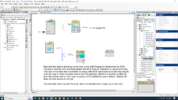I have a 50KTYZ syncronous 1RPM motor I got for a swimming pace clock. Only, it turns out to be actually 1.1 ish RMP @ 50 hz. Using the 50KTYZ as it is a BIG clock - so lots of torque needed
So, having an electronics background (but not for about 25 years!) I thought, no problem; i'll do a simple 50hz ish adjustable osc circuit with a 240v output.
(the mains stage is simple - lol, and safe I'm not messing with mains voltages unknown - just a lot of respect
I'm not messing with mains voltages unknown - just a lot of respect 
I kinda assumed the circuit would be simple and based on an off-the-shelf chip and a crystal. Crystal for stability and a chip to control dividing down to low frequency and some adjuster - either analogue (a skeleton pot based, to set the freq and then leave it alone) or maybe a 16-bit (for good/fine adjustment resolution) based digital setup.
However, this seems more complex than I thought... Could any of the folks here suggest a starting point? Basically, I'm looking for an output with 50% duty cycle, and adjustable (with fine adjustment) between about 50 and 60hz output and then very stable.
So, having an electronics background (but not for about 25 years!) I thought, no problem; i'll do a simple 50hz ish adjustable osc circuit with a 240v output.
(the mains stage is simple - lol, and safe
I kinda assumed the circuit would be simple and based on an off-the-shelf chip and a crystal. Crystal for stability and a chip to control dividing down to low frequency and some adjuster - either analogue (a skeleton pot based, to set the freq and then leave it alone) or maybe a 16-bit (for good/fine adjustment resolution) based digital setup.
However, this seems more complex than I thought... Could any of the folks here suggest a starting point? Basically, I'm looking for an output with 50% duty cycle, and adjustable (with fine adjustment) between about 50 and 60hz output and then very stable.



